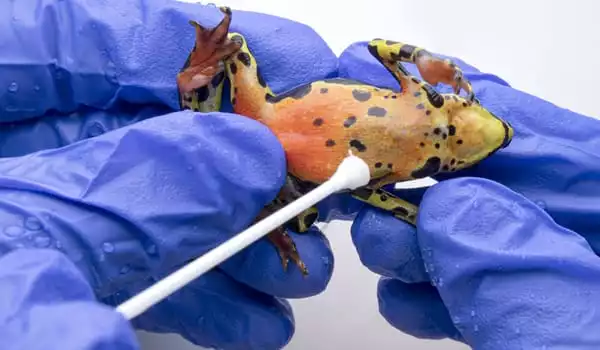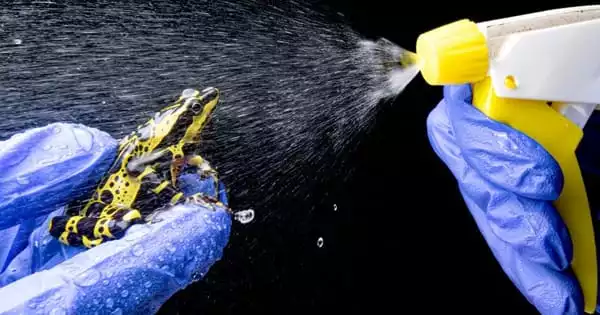Biologists claim that further research on the colorful yet toxic harlequin toads of Central and South America is needed, not only because their ecology is unknown, but also because their toxins are unknown. Because animal and plant toxins are frequently used as inspiration for novel medications, the extinction of toads due to habitat destruction and fungal infections entails a loss of poison diversity as well as genetic diversity.
While frog and salamander reductions around the world have prompted scientists to speak out about the need of preserving amphibian genetic variety, two biologists from the University of California, Berkeley, underline another essential reason for keeping these animals: their toxins.
Rebecca Tarvin and Kannon Pearson underline in a recent analysis of an endangered population, the gorgeous, yet toxic, harlequin toads of Central and South America, how little is understood about the toxins these creatures create or sequester, or why they have them at all. Despite this, the majority of the 113 known species of harlequin toads are in decline, and a quarter may already be extinct.
Given that animal poisons have shown to be a valuable source of pharmaceuticals (drugs are currently on the market derived from snake and snail venom, and toxins from the pufferfish, centipede, and scorpion are being tested), inspiration for new drugs will be lost along with the creatures.
The most significant reason I’m studying them is since they’re virtually extinct. If there is anything we can do to assist them in recovering or learning more from them before they become extinct, we must do it. It is our obligation.
Professor Navarrete.
“There are nine species of Atelopus in Central America, and seven of them have been investigated for toxin diversity and amount,” said Tarvin, a UC Berkeley assistant professor of integrative biology. “However, the bulk of the Atelopus species live in South America, where only a small number of investigations have been conducted. There are countries where not a single species has been assessed, such as Bolivia and Guyana. We are not aware of any reports of Indigenous people using them. We don’t know if they’re dangerous or not. One of the key conclusions from our work is that by eradicating these species, we are likely to lose some chemical diversity as well. They contain poisons found nowhere else on the planet.”
Tarvin is most interested in how dangerous species, which include monarch butterflies and mussels as well as snakes and frogs, evolved to synthesize poisons, eat hazardous plants and animals and sequester their poison, or host toxin-producing bacteria without succumbing to the toxins. Toxins of various origins are found in several species of harlequin toads, which is unique in the animal kingdom. They contain skin bacteria that create poisons such as tetrodotoxin, but the toads also produce their own toxins, such as bufadienolides (bufo is Latin for toad).
“One of my very first research projects was with Atelopus toads in Ecuador, and I really love them,” Tarvin, who also works as an assistant curator of herpetology at UC Berkeley’s Museum of Vertebrate Zoology, said. “However, there is a lot that is unknown from a scientific standpoint, and they are a major conservation issue. As a result, I believe they are a priority. Some of the species are flourishing well, but chytrid has taken a heavy toll on them (a fungal disease). Many species were wiped out totally.”
According to a 2005 survey, 81 percent of the 53 Atelopus species with relevant data were in decline, and 56 percent were likely extinct. The Panamanian golden frog (Atelopus zeteki) is extinct in the wild, but its remaining members were saved and are being reared in captivity before being released back into the wild. These decreases have been linked to habitat degradation and loss, as well as chytridiomycosis, or chytrid.
Tarvin and Pearson, who lead the paper as an undergraduate transfer student and is now a graduate student in Tarvin’s lab, will publish their review in Toxicon: X, the official open-access journal of multiple worldwide associations that study animal, plant, and microbial toxins, in the March edition.

Once abundant toads now rare
The increasing vanishing of harlequin toads became true to graduate student Mara José (Majo) Navarrete-Méndez only after she discussed it with her grandparents. The family used to see the colorful toads, known as jambato, all the time on their property in the region of Imbabura, Ecuador, as recently as the 1980s. Today, you’d be lucky to come across any, according to Navarrete. While chytrid is most certainly a factor in their extinction, she believes habitat damage was and continues to be a big concern. The longnose harlequin toad (Atelopus longirostris), a photo of which was uploaded this week on Instagram by actor and activist Leonardo di Caprio, is at the center of protests against the environmental destruction caused by a proposed mining in Ecuador’s Intag Valley.
The beauty and sensitivity of these toads compelled her to research them and their toxins after she joined Tarvin’s lab a year ago, fresh from the Pontifical Universidad Católica del Ecuador in Quito, Ecuador’s capital, where she earned her undergraduate degree.
“My grandparents lived in the countryside — they were campesinos — and they remembered (the toads) being incredibly common,” Navarrete explained. “I began to realize that we are in a race against time, and if it is not me, and if it is not now — we still have them available, and we have the technology and resources to study them — it may be too late later.”
The UC Berkeley researchers examined published papers for studies on the poisons of just 16 harlequin toad species out of 113 identified species in the new study, in which Navarrete was not engaged. Toxins known as guanidinium alkaloids, such as tetrodotoxin and zetekitoxin, which was first discovered in the Panamanian golden frog, were found in around half of these toads. A single Panamanian golden frog’s skin is thought to contain enough toxins to kill 1,200 mice. Tetrodotoxin is also created by pufferfish, which are eaten as the delicacy fugu in Japan despite the fact that their organs contain lethal levels of the poison.
These poisons, according to Pearson, are most likely created by bacteria living on the skin, however this has yet to be established for the majority of amphibians known to host tetrodotoxins. Bufadienolides, cardiac glycosides generated by the frog, were found in four harlequin toad species. Cardiac glycosides can cause cardiac arrest and other symptoms by interfering with the sodium/potassium pump in cells.
Using the new survey as a foundation, all three researchers intend to conduct further research on Atelopus, both in South America and in Tarvin’s lab at UC Berkeley, to determine whether and how the toads create these toxins, as well as what they do with them. While the brilliant colors of the toads indicate that they are dangerous and act as a warning to predators, not all Atelopus may carry toxins. Tarvin further suggested that the poisons could be used to defend toads against sickness, such as the chytrid fungus, to assist them communicate with other members of their species, or to show a toad’s reproductive fitness.
Related studies on the tetrodotoxin generated by a California salamander, the rough-skinned newt (Taricha granulosa), may give light on how amphibians acquire the bacteria on their skin that produce these poisons, according to Navarrete.
“The most significant reason I’m studying them is since they’re virtually extinct. If there is anything we can do to assist them in recovering or learning more from them before they become extinct, we must do it. It is our obligation, “According to Navarrete.
Several conservation organizations, including the Atelopus Survival Initiative, have popped up to help save the toads. And some previously thought-to-be-extinct species have been rediscovered. However, the genus’s fate is unknown.
“Despite the enthusiasm and interest in these animals, we know very little about their chemical defenses, which looks to be quite important. Extinction of Atelopus poses a hazard to the diversity of unidentified toxins “Pearson stated this.





